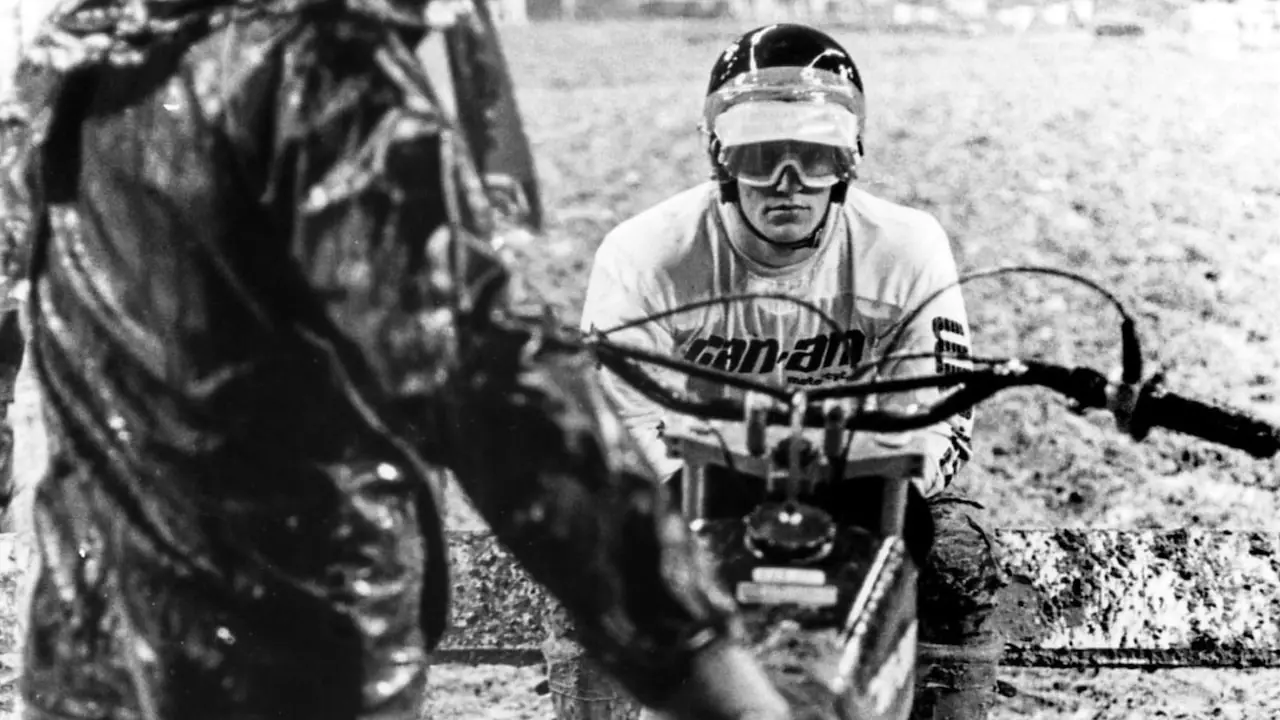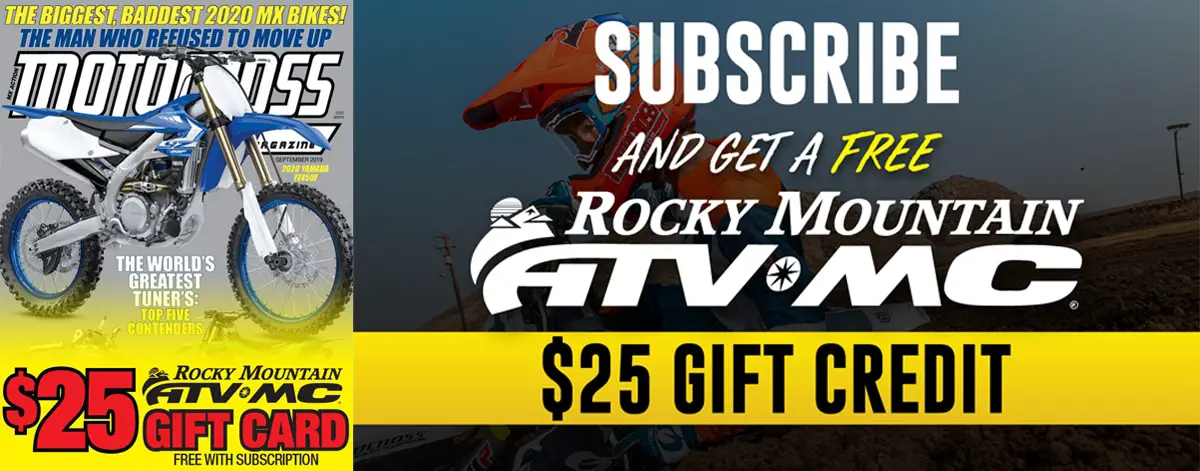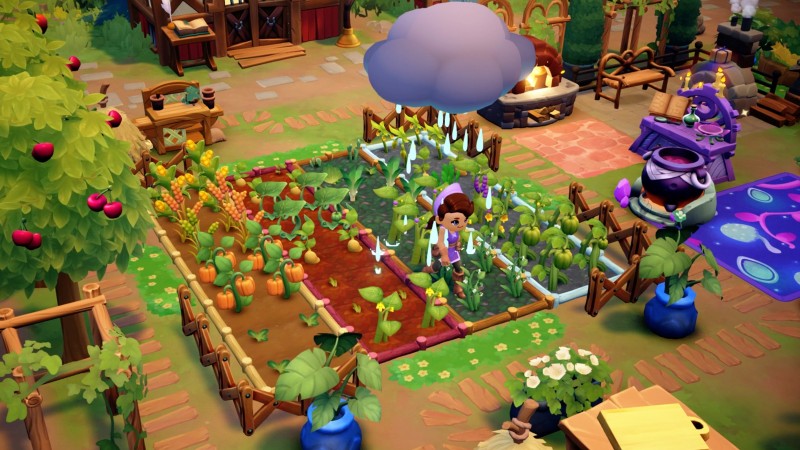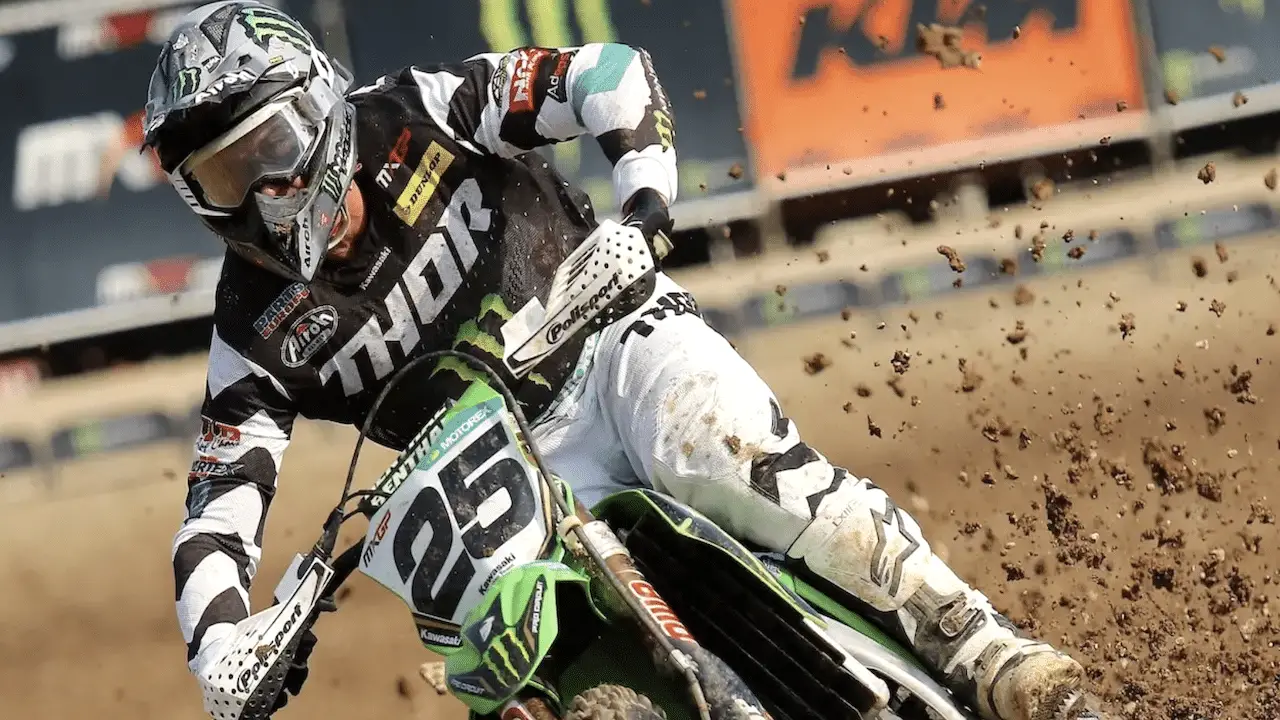

BY JIM KIMBALL
JIMMY, DIDN’T YOUR DAD INTRODUCE YOU TO MOTORCYCLES? Yes, Dad was racing enduros, and the whole family went to the races in a Ford van. As little kids, my two sisters, my brother and I played while Dad raced. We had to go because we were all under 9 years old at the time and couldn’t be left home alone.
I kept saying, “Can I race? Can I get a bike?” Initially, it was all, “No, no, no,” and then one day Mom and Dad agreed. I was excited and expected it for Christmas, but it was not under the Christmas tree. I was devastated and moped around for a while before Dad said, “Come out to the garage.” We went to the garage, and there was the bike. I can still remember that day. There was 2 feet of snow on a yard, and I dug a path to ride on.
AND THEN IT BEGAN. That was when I started riding a lot. Prior to that, I was riding a motorcycle that I could not touch the ground on. It was owned by one of the drivers that worked for my dad in the garbage truck business.
It was a Zundapp 250 and was basically a piece of junk. I had to stand on a big box to get going. I could not touch the ground, and if I stalled it, that is where I fell off and the riding ended. Once it was full of fuel, I rode it around and around and tried hard not to fall, as I couldn’t pick it up to restart it. Shortly after that, I got the Christmas minibike. Of course, I couldn’t touch the ground on that, either.
WHAT CAME NEXT? We got a Yamaha 100, like what men used to ride. This was like the old step-through Honda. It was a little big for me. It had the carburetor on the side of the engine where the rear brake was, so it was easy to stand on the top of the case instead of putting your foot on the brake. I used to ride it morning, noon and night, and the only time I stopped was when my parents called me in for bed.
“WE HAD BOUGHT A 100CC BULTACO LOBITO, AND OVER THE CHRISTMAS AND NEW YEAR HOLIDAYS, DAD PUT IT IN THE LIVING ROOM. THAT IS WHERE HE BUILT IT. HE HAD THE FRAME POWDERCOATED WHITE, WITH A BLUE GAS TANK TO GO WITH MY BLUE HELMET.”
WHEN DID YOU START RACING? Monson, Massachusetts, was my very first race, and I finished second. We began racing all the other tracks around Connecticut. I seemed to constantly finish second, but then finally I took a first. I was 10 years old, and after that I got a sponsorship from Boston Cycles.
We had bought a 100cc Bultaco Lobito, and over the Christmas and New Year holidays, Dad put it in the living room. That is where he built it. He had the frame powdercoated white, with a blue gas tank to go with my blue helmet. I could barely touch the ground on the Bultaco because I was still such a little guy, but I started winning. And, once I started winning, I just didn’t’ stop winning.
HAD MOTOCROSS HIT NEW ENGLAND YET? No, “scrambles” was what they were called when I started. Nothing was ever called “motocross” before then.
We were flat-tracking in New Hampshire at Louden on Thursday nights. Friday night we would race at Waterford, Connecticut. Then, I would race over the weekend in New Hampshire. That was fun, because I was riding a true motorcycle.
I only competed against guys riding Yamaha 250s and 360s. They would outrun me down the straightaway, but I was faster everywhere else and would beat them all by the finish line.
I was making a thousand dollars on a Thursday night, a thousand dollars on a Friday night and a thousand dollars more on a Sunday!

THAT IS IMPRESSIVE MONEY FOR A KID! I was making more money than many parents! As I said, I literally rode the bike constantly. Every time my eyes were open, I was on the bike, and when it was time to go to sleep, I stopped. I never got off the bike. That enabled me to quickly improve.
WAS THERE A MOMENT YOU DECIDED “HEY, I CAN MAKE A CAREER BY RACING DIRT BIKES”? As a kid, I did not even remotely look at it that way. I looked at it as, “Where are we going to race this weekend?” I did not care if it was raining, and we were in 19-foot-deep mud. It did not matter if there was snow on the ground, I would still ride. While riding on a lake once, I fell through the ice!
WHEN DID YOU TURN PRO? When I turned 16, we went to Lexington, Ohio, and I rode with Jimmy Weinert and the other racers. Those guys were all new to me. I was riding a Yamaha DT1 250. These were the so-called “fastest guys in America,” and I went out there that day and absolutely smoked them.
I said to my dad, “If these are the fastest riders we have in America, these guys need to learn how to ride a motorcycle.” I never looked at it as a business. I never looked at it as a way to make money, either, but I was the only kid in school that had three brand-new cars. No one else even had one car!
YOU DID OUTDOOR NATIONALS ON THAT YAMAHA, RIGHT? Yes, they sponsored me until I got picked up by Can-Am. We traveled south to do the Florida series. It was a learning curve for me, because it is all sand down there. The races were 40-minute-plus-two-lap motos. I did not care how long the races were. The longer the better, because you could see people getting tired. I never got tired or got arm pump.
DON’T YOU GET ARM PUMP WHEN RIDING A DIRT BIKE? I have, but not often. The number-one reason you get arm pump, and people do not understand this, is that you are sitting in the wrong spot on the bike. Secondly, the handlebars are in the wrong configuration, the wrong bend, or too wide for the width of the rider’s shoulders and wrists. That is why people get arm pump. I used to do a lot of motocross schools after I moved to Australia. I found that if you want to learn how to ride, you can learn more in a parking lot than riding on a motocross track, where you don’t learn anything.
These days, everyone says, “I had a good practice today.” No, you didn’t. All you did was wear out the bike and yourself. You did not learn anything, because you are doing the same lines, on the same track and trying to go fast. That does not work. You need to learn. If I struggled using the front brake, my dad would take the back brake off. Then I had no choice but to use the front brake. If I sat down and the track was rough, he would take the seat off. Dad was like a genius back then, although I did not think he was anything but an idiot at the time.
SO, YOUR DAD KNEW WHAT HE WAS TALKING ABOUT? Dad had me starting to ride with one hand. I would take my clutch hand and basically put it on my lap. You do that for a week, not a day, while you are riding 10 hours a day, only coming back for fuel. You don’t need two hands if you are in the right spot on the bike and are in shape. I proved that point to many people over the years. I did some big triple jumps using only one hand. Honestly, you don’t need two hands on a motorcycle, but you must practice a lot.
Doing backflips nowadays is like second nature for most people. I did a backflip back in 1969, and dad absolutely lost it. He was so mad at me. He didn’t see me crash the 10 times before I accomplished it. I did it off the picnic table right there in the yard.
YOU DID A BACKFLIP IN 1969? I would almost like to say that I was the first one to ever do a backflip on a motorcycle. It was in an article in Australia but not here in the States. I have done enough interviews where that has come out, but there is no way to prove it. We did not have cameras or phones like nowadays.
Jimmy Ellis raced a privateer Yamaha before signing with Can-Am. Here is Jimmy with Gary Jones (when he was on a Maico). However, in 1974 Gary Jones, Marty Tripes and Jimmy Ellis swept the top three places in the AMA 250 National Championships for Can-Am. LET’S RETURN TO YOUR SIGNING WITH FACTORY CAN-AM. We were racing Southwick just before Can-Am approached me. I got the factory ride, because that day I raced the 125, 250 and 500 classes.>Southwick is a big track, so you are on the track all day long. Before every moto, I went down to the starting line, put a different pair of goggles on, got on the bigger bike and raced that one. I won every single moto that day, and Can-Am gave us a contract. I later went to Florida to get ready for the Florida Winter Series and got hurt. It was my very first race of the year for Can-Am. I broke my hip and was on the critical list for almost a month. You know how they talk about seeing the big bright light when you almost die? Been there and done that. I was temporarily paralyzed and did not want to ride a bike anymore. I could not touch the floor. I had a hospital bed in the house once they got me home because I had shattered my hips. I could not walk on crutches. I was in traction, and I laid in bed for 16 weeks. I only raced 10 motos that year, because I missed the first 10 being hurt. And I still finished second overall. I missed the championship by three points. I needed one more moto.

HOW WERE YOU COMPENSATED? WERE YOU MAKING DECENT MONEY? I had a base salary of $25,000 a year, which was not a lot. Bonuses were not big back then. My bonus was $1000 if I won a National. But, as I said, I did not care about the money. All I cared about was riding my dirt bike. I bought a $38,000 house when I was 18. Even Bob Hannah would say, at least in the early part of his career, that he just wanted to ride; he didn’t care about the money.
YOUR DAD WAS YOUR MECHANIC FOR MANY YEARS. WAS THAT A GOOD PROGRAM? No, it was a mistake. I should never have done that. The race teams did not want a father and son team because there had never been a father and son team that had a good-enough relationship where they could be a winning team. But, I just said, “Well, if I can’t have my dad, then I won’t ride. I don’t give a crap; I want my dad.” They had to give into me, but that was ultimately a mistake.
IN 1975 YOU WON THE 250 SUPERCROSS CHAMPIONSHIP, SWEEPING EVERY ROUND, INCLUDING THE FINAL ROUND AT THE L.A. COLISEUM. That is exactly true. And, honestly, when you say the words, “L.A. Coliseum,” it feels like I am still standing there. It was good, and I felt like a rock star. The track was swarming with spectators who were coming from the stands onto the field. On the very last lap, I had to slow down because I was going to run people over. The cops carried me from the center of the field all the way up to the press box. People wanted any piece of me they could get, whether it was a helmet, goggles, gloves or shirt. It was Los Angeles, and it was crazy!
WHILE YOU WERE AT CAN-AM, I’M ASSUMING OTHER MANUFACTURERS WERE TRYING TO SIGN YOU? Yes, Honda and Yamaha both wanted me, but it was like jumping from one fire into another fire. Every motorcycle was having issues then. Dad and I talked about it, and I had no problem with Can-Am. They were just as good as any other bike out there. We all had no suspension, but we all had good mechanics.
HOW WAS 1976? We were starting to struggle, and I probably should have left Can-Am and moved on. Still, I won the Dallas Supercross, and repeated my L.A. Coliseum Supercross win. Can-Am would not let me practice on the bike; I barely ever saw it. I could only ride it with them at the track. They would say, “Ride three laps and then get off the bike.” Then they would write stuff down and start changing things. They would change the front tires, rear tires, exhaust pipes and everything. I would tell them what I liked, but they would ignore me. It seemed like they were testing me, not the motorcycle, to see how much I knew. It was strange. Can-Am had the very first Monoshock. It was called the “rubber bike.”
I NEVER HEARD OF THE “CAN-AM RUBBER BIKE.” It was made with a 7-inch chunk of rubber, 4 inches round. No shock, just rubber. You could hit the biggest object in the world. It could be a 2-foot rock, and the bike would just absorb it. They could not patent it, because Yamaha had already done that with the Monoshock. We did a lot of testing on it. That was a good bike, and I enjoyed that one. That was when everyone was experimenting with the shocks. They were getting laid down instead of being straight up and down.
YOU WERE WITH CAN-AM AGAIN IN 1977 BUT SIGNED WITH HONDA FOR 1978. 1977 was okay, and I won a Supercross and an outdoor National, but it seemed the Japanese bikes were getting much better. I accepted an offer from Honda and went there for 1978. All the money was the same back then. I felt that the Honda was more dependable than the other ones. I always said, “Suzuki does nothing but make sewing machines. Kawasakis are green, and nobody races green bikes. Green is bad luck.”
AT THAT TIME, HONDA WAS REALLY BUILDING UP THE U.S. TEAM. They did put a lot of money into the team, there is no doubt. It was one step bigger than everybody else. It was good, and I enjoyed riding for Honda. In Japan, we went to the research and development bike side, and they were riding bikes that were four or five years newer than what we had or had ever seen. They still do that to this day.
WHAT IS THE HIGHLIGHT OF YOUR HONDA YEARS? I was there almost three years, but I can’t say I had a highlight. 1978 was okay, but I struggled in 1979. I did argue with them at times. It did not matter how good my ideas were, Honda didn’t like it. Honda believed their bike was better than any other bike, but Kawasaki, Yamaha and the others all felt the same. The Japanese don’t want to lose face. It is part of their culture and the way they have been brought up.
Remember when people were losing chains going through ruts? My dad invented a chainguide roller on the bottom of the swingarm where the back sprocket is, and we as the family could not patent it or do anything. Honda owned it, and it was written in the contract. They owned any ideas you had. So, if you came up with a good idea, you had to let them think it was theirs in order to use it. Those guide and rollers came from my dad. The handlebars we used were from an idea that Gary Jones had. Back then, handlebars were easy to bend. It was hard to finish a race with the handlebar bent down near the fuel tank. The Gary Jones handlebar didn’t bend as much.
HOW MUCH WAS HONDA AGAINST HAVING YOUR DAD AS YOUR MECHANIC? They hated it and did not want that at all. But my dad was a great mechanic for me, until things went sideways—and they went bad very quickly. Things happened personally that just absolutely killed me, destroying my family, my marriage and my career. I also had a knee that kept popping out. These two events ended my racing career in America!
WHAT HAPPENED? Things went pear-shaped in my life. I want to tell you what happened, but it is hard to tell unless I am talking face-to-face with someone.

HOW DID THE MOVE TO AUSTRALIA PRESENT ITSELF TO YOU? I did race some in 1980 with the PDQ Yamaha privateer team, but I struggled. So, in 1980, I got my knee fixed and was racing on and off in America. Later, in 1983, a guy called me up from Australia at 2 a.m. in the morning wanting to know if I would come to Perth, Australia, and I said “Where?”
He repeated, “Perth.”
I did not know what this guy was talking about, because he was talking funny.
I said, “Send me a ticket.” This was when we had paper tickets. I got a ticket about three weeks later and said, “Okay, I will come.”
They paid me $2000 to show up, win or lose, plus I got the prize money. I thought it was the longest flight of my whole life. They sent me from Connecticut to Chicago to Denver to L.A. to Hawaii to Tahiti to New Zealand to Bridgetown to Sydney to Adelaide, and when I landed in Perth, I was the meanest Yankee you have ever seen. He got the cheapest airline ticket he could find! After landing, I asked him to get me to the hotel. He told me there were no hotels, and I’d be staying with a family! I was not a happy guy, but it ended up being a very nice family.
AND YOU STAYED IN AUSTRALIA FOR MANY YEARS, RIGHT? First, I made the trip back and forth every 10 days. Three months later, I am thinking, “What day is it? What month is it?” I didn’t even know. I thought, “I can’t do this anymore. I will just stay.” I stayed for 35 years!
HOW WAS LIVING IN AUSTRALIA? I would go back today. America has become a third-world country. I don’t like saying that, but it’s true. It is sad to say and sad to hear that, but that is just my view on it. America thinks they are bigger, better and stronger than everyone else, when really you just have to look around to see that is not true anymore.
HOW WAS THE RACING IN AUSTRALIA FOR YOU? I had a five-year contract to test for KTM. We were testing all the water-cooled bikes that were not out yet. We did break them a lot. I broke a lot of wheels, shocks and forks. As far as racing, I won pretty much everything. I had not ridden for about a year at that stage, and I said, “Man, is this as fast as these guys go?” I was a bit surprised. Eventually, they started to pick up the pace. It took a while, but they did.
YOU STAYED IN AUSTRALIA AFTER MOTOCROSS. WHAT DID YOU DO? I did not want to come back to America. Of course, I only knew motocross and had never worked a job in my life, but I was a quick learner.
I began doing construction work. I made doors, gates and fences. Later, I bought a company for about $18,000 that built picket fences. It took me almost two years to make the biggest picket-fence machine in the country. I could make 10,000 pickets in an hour with this machine once I got it. I was buying the wood right from the tree basically. Then Bunnings, which is the Home Depot of Australia, squeezed me out and I sold it.
THEN YOU NEEDED SOMETHING NEW TO DO. I did not know what else to do. My neighbor had a mechanic shop, along with some money, and I said, “Look, I want to race cars. Let’s buy a go-kart.” We went out and bought a go-kart. It was a Reed kart, which was the fastest go-kart around. I had to start last because I was a brand-new guy. I did this for three races, and I went out and won them all. Then I said, “This thing is not fast enough. I don’t want to do this.”
So, I talked to my neighbor again and said, “How about we buy a real car?” We bought a six-cylinder SS Chevelle 396, but I grew bored of that and wanted to do something with more speed!
DIDN’T YOU EVENTUALLY RACE NASCAR? Yes, despite everyone telling me, “You are never going to race NASCAR. Do you know how much money it costs to race NASCAR?”
I said, “I don’t care how much money it takes, I want to race NASCAR. About four months later, I was racing NASCAR with a half-million-dollar sponsorship. I had never raced one before and did not even know how to drive one. It scared me to death. I could never win a NASCAR race, but I am telling you that the feeling when in the car was better than anything else.
WHEN YOU WERE IN AUSTRALIA, YOU GOT REMARRIED, RIGHT? Yes, I was married in the Australian East Coast to Sally. But, to this day, I have not seen the girl, except for maybe twice since 2001, but I am still married to her.
“I LIKELY COULD HAVE MADE MUCH MORE MONEY, AS MY CAREER WAS SOMEWHAT SHORT-LIVED. BUT, IN THE BIG PICTURE, IT WAS NEVER ABOUT MONEY!”
WHAT? Yes, it’s true. Here is a crazy story for you. I had a vasectomy in America, but Sally said she wanted kids. So, I had a reverse vasectomy, which was extremely painful. We ended up having a son named Lee. He is now 32 years old and is getting his pilot’s license to fly for Qantas.
He has two little kids that I have never met—Lincoln and Liam. I have seen photos on Facebook, and they are beautiful little kids. I have not been able to talk to any of them. I walked right past my wife when I was at the wedding when my son got married in 2019. I had only seen her once before that in 20 years, and I walked right by her. She stopped me and said, “Oh, you are not going to talk to me?” She was a whole different girl than what I remember.
WHEN DID YOU RETURN TO AMERICA? In 2018 I got back.
DO YOU HAVE ANY FAMILY LEFT IN THE STATES? I have three kids altogether, two from my first wife Darlene. My daughter Katie lives in Missouri. A long time ago, she was dating a guy who was dealing drugs. The police did a raid, so she ate a bag of drugs and ended up in a coma for five months. This was when I was still living in Australia. One day we had to unplug the life-support machine. My ex-wife and I made the decision over the phone. It tore me apart. They were afraid that if I came home, I was going to kill somebody for contributing to my daughter’s condition. But, eventually, she woke up from the coma. She is basically a five-year-old in a woman’s body today.
My son Troy is a superintendent at a big construction site, building 300-unit apartments now. I work with him every now and again. I don’t get paid anything, but will work down there for 12 hours a day. I like to keep busy.

DO YOU FOLLOW MODERN MOTOCROSS? Not really. These guys don’t know how to set up bikes, and it makes me angry. Their bikes handle like garbage—just watch them. They don’t go any faster than we used to go. The motorcycles just don’t handle very well. They don’t know what they are doing, setup-wise. I may not know much about engines, but I am a good suspension guy.
Also, the training is so different now, and everyone hires a trainer. When I was racing motocross in Australia, I would get up at 4:30 in the morning. I would get all dressed up like I was going to do the Tour de France and ride 65 miles on my bicycle. Then, I would park the bicycle and go for a run for an hour. I did that every day, five days a week, and then I would go to the gym and do an hour or two of weights.
That was my day—every day. I never went riding, and I did not practice. As I said earlier, when you practice on a racetrack, you don’t learn anything. I already knew how to ride. I needed to be in shape, so I focused on being in better shape than everyone else.
WHEN I THINK OF JIMMY ELLIS, I THINK OF THE LOS ANGELES COLISEUM. The L.A. Coliseum was pretty good to me. I won it in 1975 and 1976. I should have won it three years in a row, but we broke the steering head off the bike in 1977. The AMA would not let us replace the frame, even though we had plenty of time. I even had another bike there.
So, I had to sit in the stands and watch the race. I was devastated, because I should have won it. I sat with Bruce Jenner, watched the whole race, then went home disappointed. If the riders would have agreed to it, I could have changed the frame, but the riders would not agree to it. The AMA said, “Well, it is up to the riders.
They asked the riders if I could use another bike, and my competitors said, “Nope.” The riders took me out. I was hurt by that.
WHAT ARE YOUR FINAL THOUGHTS ABOUT YOUR RACING CAREER? I probably could have been more successful if I had come on the scene 10 years later. Nobody was looking at New England as a place for motocross riders. I likely could have made much more money, as my career was somewhat short-lived. But, in the big picture, it was never about money! It was a family-type sport back when we were all caravaning to the races and not flying. I could tell you many more stories, there is no doubt about that.
MXA INTERVIEW: JIMMY ELLIS DIDN’T CARE ABOUT THE MONEY Motocross Action Magazine.




















You must be logged in to post a comment Login